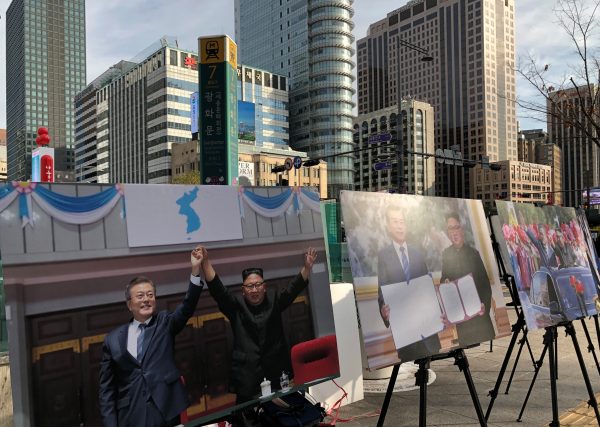Inter-Korean rapprochement has always been the essential pre-condition for Seoul’s realisation of its middle power potential. During the presidencies of Kim Dae-jung and Roh Moo-hyun from 1998 to 2008, sustained South–North efforts began to bear fruit. They did so because Kim and Roh insisted that domestic democratic advancement was required to both confront and engage North Korea.
The exercise of South Korea’s middle power status was delayed by the decade that followed, when corruption limited the administration’s domestic legitimacy and unrealistic strategies toward the North were pursued. From 2008 to 2017 familiar illiberal elements in South Korea delayed the modernisation of economic and diplomatic structures, and resisted the strategic reset that cooperative North–South peace-building would produce.
Moon Jae-in’s election in May 2017 returned South Korea to its earlier trajectory, aiming for domestic accountability and inter-Korean rapprochement. In a lucky coincidence, North Korea’s Kim Jong-un was preparing to shift direction in an attempt to escape economic isolation and barter his nuclear programs for peace with the United States.
As a result, diplomatic events throughout 2018 in Northeast Asia and the United States have altered the status quo in ways that are probably irreversible, even if additional agreements are needed.
The key difference between then and now is the position of the United States. All through the 1990s the United States was carefully exploring ways to engage Pyongyang on the nuclear issue while maintaining deterrence. This continued through the 1994 US–DPRK Agreed Framework and was strengthened by the election of the engagement-minded Kim Dae-jung.
Today, the North and South Koreans are again ready to move ahead. But the United States, despite President Donald Trump’s unconventional theatrics and willingness to abandon military bluffs, is not capable of playing a leading role.
The Trump approach has certainly contributed important elements to the Peninsular thaw throughout 2018. US rejection of 15 years of counterproductive White House policy, abandonment of major military exercises and a summit meeting with Kim served to remove the United States as an obstacle to diplomatic progress.
But these actions appear to have exhausted the Trump administration’s positive contributions. Elements of the previous ‘strategic patience’ thinking are reasserting themselves in Washington. Trump hired John Bolton, enemy of previous North Korea and Iran nuclear deals, as his national security advisor. Trump himself shows no sign of grasping how the United States could complete its pivot to facilitating, rather than obstructing, denuclearisation.
This is the situation facing the Moon government as it looks to 2019 and beyond. The myth that the US–South Korea alliance is fragile, and that Seoul must give in to shifting demands from Washington, still haunts the Blue House. So it may be understandable that the United States was dragged into the centre of rapidly developing North–South relations in 2017 and 2018, even though it is more confused and less able to make policy than at any time in memory. With North–US diplomacy on hold, Seoul alone has the flexibility to drive the process toward a durable deal. But how?
Verifiable capping and rollback of North Korea’s nuclear and missile capabilities will now require major relief from UN sanctions. This has always been the case — denuclearisation is only possible in a changed diplomatic relationship with the United States. But if Kim Jong-un is serious about trading nuclear and missile capabilities for economic and diplomatic openings, he is discovering that the United States is perhaps not. Some in South Korea are coming to the same conclusion.
The outlines of a deal are little changed from the 1990s, and good suggestions have been offered. Former South Korean unification minister Lee Jong-seok points out that, fair or not, the current US administration needs North Korea to put out its offer first. That offer should consist of a large and serious act of denuclearisation. Former special advisor for nonproliferation at the US State Department Robert Einhorn suggests that an appropriate act would be for North Korea to identify all sites where fissile materials are produced, freeze them and then open them for inspection. If Kim Jong-un were to make such an offer, the subsequent drive for significant UN sanctions relief should be successful despite expected US resistance.
Seoul may now have to do what it declined to do in 2017 and 2018: put forward a deal that has benefits for both sides, demand help from neighbours and allies, and use the United Nations to help secure progress on the linked nuclear and economic development deals. Many specialists believe such a deal is entirely possible.
Nineteen months of hard and bold work has paid off in multiple ways. But the complexity and requirements of navigating these issues demand a decision from South Korea to lead in its alliance with the United States, using the tools available to a middle power.
The Moon administration cannot expect its luck to continue. Instead, it will have to make its own luck.
Stephen Costello is an independent analyst and consultant, and the producer of Asia East. He was formerly director of the Korea Program at the Atlantic Council and director of the Kim Dae Jung Peace Foundation.
This article is part of an EAF special feature series on 2018 in review and the year ahead.


Thanks for a thoughtful analysis. Assuming Moon can/will take some more initiative he will have more success if he can find a way to do so that will allow Trump to take credit for at least part of it. This is because Trump is largely motivated by self gratification/glorification. Admittedly, this will be a challenge for Moon, as well as Kim in the DPRK. Can they pull it off?